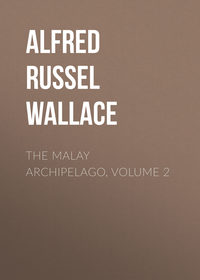 полная версия
полная версияThe Malay Archipelago, Volume 1
The Mias rarely descends to the ground, except when pressed by hunger, it seeks succulent shoots by the riverside; or, in very dry weather, has to search after water, of which it generally finds sufficient in the hollows of leaves. Only once I saw two half-grown Orangs on the ground in a dry hollow at the foot of the Simunjon hill. They were playing together, standing erect, and grasping each other by the arms. It may be safely stated, however, that the Orang never walks erect, unless when using its hands to support itself by branches overhead or when attacked. Representations of its walking with a stick are entirely imaginary.
The Dyaks all declare that the Mias is never attacked by any animal in the forest, with two rare exceptions; and the accounts I received of these are so curious that I give them nearly in the words of my informants, old Dyak chiefs, who had lived all their lives in the places where the animal is most abundant. The first of whom I inquired said: "No animal is strong enough to hurt the Mias, and the only creature he ever fights with is the crocodile. When there is no fruit in the jungle, he goes to seek food on the banks of the river where there are plenty of young shoots that he likes, and fruits that grow close to the water. Then the crocodile sometimes tries to seize him, but the Mias gets upon him, and beats him with his hands and feet, and tears him and kills him." He added that he had once seen such a fight, and that he believes that the Mias is always the victor.
My next informant was the Orang Kaya, or chief of the Balow Dyaks, on the Simunjon River. He said: "The Mias has no enemies; no animals dare attack it but the crocodile and the python. He always kills the crocodile by main strength, standing upon it, pulling open its jaws, and ripping up its throat. If a python attacks a Mias, he seizes it with his hands, and then bites it, and soon kills it. The Mias is very strong; there is no animal in the jungle so strong as he."
It is very remarkable that an animal so large, so peculiar, and of such a high type of form as the Orangutan, should be confined to so limited a district—to two islands, and those almost the last inhabited by the higher Mammalia; for, east of Borneo and Java, the Quadrumania, Ruminants, Carnivora, and many other groups of Mammalia diminish rapidly, and soon entirely disappear. When we consider, further, that almost all other animals have in earlier ages been represented by allied yet distinct forms—that, in the latter part of the tertiary period, Europe was inhabited by bears, deer, wolves, and cats; Australia by kangaroos and other marsupials; South America by gigantic sloths and ant-eaters; all different from any now existing, though intimately allied to them—we have every reason to believe that the Orangutan, the Chimpanzee, and the Gorilla have also had their forerunners. With what interest must every naturalist look forward to the time when the caves and tertiary deposits of the tropics may be thoroughly examined, and the past history and earliest appearance of the great man-like apes be made known at length.
I will now say a few words as to the supposed existence of a Bornean Orang as large as the Gorilla. I have myself examined the bodies of seventeen freshly-killed Orangs, all of which were carefully measured; and of seven of them, I preserved the skeleton. I also obtained two skeletons killed by other persons. Of this extensive series, sixteen were fully adult, nine being males, and seven females. The adult males of the large Orangs only varied from 4 feet 1 inch to 4 feet 2 inches in height, measured fairly to the heel, so as to give the height of the animal if it stood perfectly erect; the extent of the outstretched arms, from 7 feet 2 inches to 7 feet 8 inches; and the width of the face, from 10 inches to 13 1/2 inches. The dimensions given by other naturalists closely agree with mine. The largest Orang measured by Temminck was 4 feet high. Of twenty-five specimens collected by Schlegel and Muller, the largest old male was 4 feet 1 inch; and the largest skeleton in the Calcutta Museum was, according to Mr. Blyth, 4 feet 1 1/2 inch. My specimens were all from the northwest coast of Borneo; those of the Dutch from the west and south coasts; and no specimen has yet reached Europe exceeding these dimensions, although the total number of skins and skeletons must amount to over a hundred.
Strange to say, however, several persons declare that they have measured Orangs of a much larger size. Temminck, in his Monograph of the Orang, says that he has just received news of the capture of a specimen 5 feet 3 inches high. Unfortunately, it never seems to have a reached Holland, for nothing has since been heard of any such animal. Mr. St. John, in his "Life in the Forests of the Far East," vol. ii. p. 237, tells us of an Orang shot by a friend of his, which was 5 feet 2 inches from the heel to the top of the head, the arm 17 inches in girth, and the wrist 12 inches! The head alone was brought to Sarawak, and Mr. St. John tells us that he assisted to measure this, and that it was 15 inches broad by 14 long. Unfortunately, even this skull appears not to have been preserved, for no specimen corresponding to these dimensions has yet reached England.
In a letter from Sir James Brooke, dated October 1857 in which he acknowledges the receipt of my Papers on the Orang, published in the "Annals and Magazine of Natural History," he sends me the measurements of a specimen killed by his nephew, which I will give exactly as I received it: "September 3rd, 1867, killed female Orangutan. Height, from head to heel, 4 feet 6 inches. Stretch from fingers to fingers across body, 6 feet 1 inch. Breadth of face, including callosities, 11 inches." Now, in these dimensions, there is palpably one error; for in every Orang yet measured by any naturalist, an expanse of arms of 6 feet 1 inch corresponds to a height of about 3 feet 6 inches, while the largest specimens of 4 feet to 4 feet 2 inches high, always have the extended arms as much as 7 feet 3 inches to 7 feet 8 inches. It is, in fact, one of the characters of the genus to have the arms so long that an animal standing nearly erect can rest its fingers on the ground. A height of 4 feet 6 inches would therefore require a stretch of arms of at least 8 feet! If it were only 6 feet to that height, as given in the dimensions quoted, the animal would not be an Orang at all, but a new genus of apes, differing materially in habits and mode of progression. But Mr. Johnson, who shot this animal, and who knows Orangs well, evidently considered it to be one; and we have therefore to judge whether it is more probable that he made a mistake of two feet in the stretch of the arms, or of one foot in the height. The latter error is certainly the easiest to make, and it will bring his animal into agreement, as to proportions and size, with all those which exist in Europe. How easy it is to be deceived as to the height of these animals is well shown in the case of the Sumatran Orang, the skin of which was described by Dr. Clarke Abel. The captain and crew who killed this animal declared that when alive he exceeded the tallest man, and looked so gigantic that they thought he was 7 feet high; but that, when he was killed and lay upon the ground, they found he was only about 6 feet. Now it will hardly be credited that the skin of this identical animal exists in the Calcutta Museum, and Mr. Blyth, the late curator, states "that it is by no means one of the largest size"; which means that it is about 4 feet high!
Having these undoubted examples of error in the dimensions of Orangs, it is not too much to conclude that Mr. St. John's friend made a similar error of measurement, or rather, perhaps, of memory; for we are not told that the dimensions were noted down at the time they were made. The only figures given by Mr. St. John on his own authority are that "the head was 15 inches broad by 14 inches long." As my largest male was 13 1/2 broad across the face, measured as soon as the animal was killed, I can quite understand that when the head arrived at Sarawak from the Batang-Lupar, after two or three days' voyage, it was so swollen by decomposition as to measure an inch more than when it was fresh. On the whole, therefore, I think it will be allowed, that up to this time we have not the least reliable evidence of the existence of Orangs in Borneo more than 4 feet 2 inches high.
CHAPTER V. BORNEO—JOURNEY INTO THE INTERIOR
(NOVEMBER 1855 TO JANUARY 1856.)As the wet season was approaching, I determined to return to Sarawak, sending all my collections with Charles Allen around by sea, while I myself proposed to go up to the sources of the Sadong River and descend by the Sarawak valley. As the route was somewhat difficult, I took the smallest quantity of baggage, and only one servant, a Malay lad named Bujon, who knew the language of the Sadong Dyaks, with whom he had traded. We left the mines on the 27th of November, and the next day reached the Malay village of Gúdong, where I stayed a short time to buy fruit and eggs, and called upon the Datu Bandar, or Malay governor of the place. He lived in a large, and well-built house, very dirty outside and in, and was very inquisitive about my business, and particularly about the coal-mines. These puzzle the natives exceedingly, as they cannot understand the extensive and costly preparations for working coal, and cannot believe it is to be used only as fuel when wood is so abundant and so easily obtained. It was evident that Europeans seldom came here, for numbers of women skeltered away as I walked through the village and one girl about ten or twelve years old, who had just brought a bamboo full of water from the river, threw it down with a cry of horror and alarm the moment she caught sight of me, turned around and jumped into the stream. She swam beautifully, and kept looking back as if expecting I would follow her, screaming violently all the time; while a number of men and boys were laughing at her ignorant terror.
At Jahi, the next village, the stream became so swift in consequence of a flood, that my heavy boat could make no way, and I was obliged to send it back and go on in a very small open one. So far the river had been very monotonous, the banks being cultivated as rice-fields, and little thatched huts alone breaking the unpicturesque line of muddy bank crowned with tall grasses, and backed by the top of the forest behind the cultivated ground. A few hours beyond Jahi we passed the limits of cultivation, and had the beautiful virgin forest coming down to the water's edge, with its palms and creepers, its noble trees, its ferns, and epiphytes. The banks of the river were, however, still generally flooded, and we had some difficulty in finding a dry spot to sleep on. Early in the morning we reached Empugnan, a small Malay village, situated at the foot of an isolated mountain which had been visible from the mouth of the Simunjon River. Beyond here the tides are not felt, and we now entered upon a district of elevated forest, with a finer vegetation. Large trees stretch out their arms across the stream, and the steep, earthy banks are clothed with ferns and zingiberaceous plants.
Early in the afternoon we arrived at Tabókan, the first village of the Hill Dyaks. On an open space near the river, about twenty boys were playing at a game something like what we call "prisoner's base;" their ornaments of beads and brass wire and their gay-coloured kerchiefs and waist-cloths showing to much advantage, and forming a very pleasing sight. On being called by Bujon, they immediately left their game to carry my things up to the "headhouse,"—a circular building attached to most Dyak villages, and serving as a lodging for strangers, the place for trade, the sleeping-room of the unmarried youths, and the general council-chamber. It is elevated on lofty posts, has a large fireplace in the middle and windows in the roof all round, and forms a very pleasant and comfortable abode. In the evening it was crowded with young men and boys, who came to look at me. They were mostly fine young fellows, and I could not help admiring the simplicity and elegance of their costume. Their only dress is the long "chawat," or waist-cloth, which hangs down before and behind. It is generally of blue cotton, ending in three broad bands of red, blue, and white. Those who can afford it wear a handkerchief on the head, which is either red, with a narrow border of gold lace, or of three colours, like the "chawat." The large flat moon-shaped brass earrings, the heavy necklace of white or black beads, rows of brass rings on the arms and legs, and armlets of white shell, all serve to relieve and set off the pure reddish brown skin and jet-black hair. Add to this the little pouch containing materials for betel-chewing, and a long slender knife, both invariably worn at the side, and you have the everyday dress of the young Dyak gentleman.
The "Orang Kaya," or rich man, as the chief of the tribe is called, now came in with several of the older men; and the "bitchara" or talk commenced, about getting a boat and men to take me on the next morning. As I could not understand a word of their language, which is very different from Malay, I took no part in the proceedings, but was represented by my boy Bujon, who translated to me most of what was said. A Chinese trader was in the house, and he, too, wanted men the next day; but on his hinting this to the Orang Kaya, he was sternly told that a white man's business was now being discussed, and he must wait another day before his could be thought about.
After the "bitchara" was over and the old chiefs gone, I asked the young men to play or dance, or amuse themselves in their accustomed way; and after some little hesitation they agreed to do so. They first had a trial of strength, two boys sitting opposite each other, foot being placed against foot, and a stout stick grasped by both their hands. Each then tried to throw himself back, so as to raise his adversary up from the ground, either by main strength or by a sudden effort. Then one of the men would try his strength against two or three of the boys; and afterwards they each grasped their own ankle with a hand, and while one stood as firm as he could, the other swung himself around on one leg, so as to strike the other's free leg, and try to overthrow him. When these games had been played all around with varying success, we had a novel kind of concert. Some placed a leg across the knee, and struck the fingers sharply on the ankle, others beat their arms against their sides like a cock when he is going to crow, this making a great variety of clapping sounds, while another with his hand under his armpit produced a deep trumpet note; and, as they all kept time very well, the effect was by no means unpleasing. This seemed quite a favourite amusement with them, and they kept it up with much spirit.
The next morning we started in a boat about thirty feet long, and only twenty-eight inches wide. The stream here suddenly changes its character. Hitherto, though swift, it had been deep and smooth, and confined by steep banks. Now it rushed and rippled over a pebbly, sandy, or rocky bed, occasionally forming miniature cascades and rapids, and throwing up on one side or the other broad banks of finely coloured pebbles. No paddling could make way here, but the Dyaks with bamboo poles propelled us along with great dexterity and swiftness, never losing their balance in such a narrow and unsteady vessel, though standing up and exerting all their force. It was a brilliant day, and the cheerful exertions of the men, the rushing of the sparkling waters, with the bright and varied foliage, which from either bank stretched over our heads, produced an exhilarating sensation which recalled my canoe voyages on the grander waters of South America.
Early in the afternoon we reached the village of Borotói, and, though it would have been easy to reach the next one before night, I was obliged to stay, as my men wanted to return and others could not possibly go on with me without the preliminary talking. Besides, a white man was too great a rarity to be allowed to escape them, and their wives would never have forgiven them if, when they returned from the fields, they found that such a curiosity had not been kept for them to see. On entering the house to which I was invited, a crowd of sixty or seventy men, women, and children gathered around me, and I sat for half an hour like some strange animal submitted for the first time to the gaze of an inquiring public. Brass rings were here in the greatest profusion, many of the women having their arms completely covered with them, as well as their legs from the ankle to the knee. Round the waist they wear a dozen or more coils of fine rattan stained red, to which the petticoat is attached. Below this are generally a number of coils of brass wire, a girdle of small silver coins, and sometimes a broad belt of brass ring armour. On their heads they wear a conical hat without a crown, formed of variously coloured beads, kept in shape by rings of rattan, and forming a fantastic but not unpicturesque headdress.
Walking out to a small hill near the village, cultivated as a rice-field, I had a fine view of the country, which was becoming quite hilly, and towards the south, mountainous. I took bearings and sketches of all that was visible, an operation which caused much astonishment to the Dyaks who accompanied me, and produced a request to exhibit the compass when I returned. I was then surrounded by a larger crowd than before, and when I took my evening meal in the midst of a circle of about a hundred spectators anxiously observing every movement and criticising every mouthful, my thoughts involuntarily recurred to the lion at feeding time. Like those noble animals, I too was used to it, and it did not affect my appetite. The children here were more shy than at Tabókan, and I could not persuade them to play. I therefore turned showman myself, and exhibited the shadow of a dog's head eating, which pleased them so much that all the village in succession came out to see it. The "rabbit on the wall" does not do in Borneo, as there is no animal it resembles. The boys had tops shaped something like whipping-tops, but spun with a string.
The next morning we proceeded as before, but the river had become so rapid and shallow and the boats were all so small, that though I had nothing with me but a change of clothes, a gun, and a few cooking utensils, two were required to take me on. The rock which appeared here and there on the riverbank was an indurated clay-slate, sometimes crystalline, and thrown up almost vertically. Right and left of us rose isolated limestone mountains, their white precipices glistening in the sun and contrasting beautifully with the luxuriant vegetation that elsewhere clothed them. The river bed was a mass of pebbles, mostly pure white quartz, but with abundance of jasper and agate, presenting a beautifully variegated appearance. It was only ten in the morning when we arrived at Budw, and, though there were plenty of people about, I could not induce them to allow me to go on to the next village. The Orang Kaya said that if I insisted on having men, of course he would get them, but when I took him at his word and said I must have them, there came a fresh remonstrance; and the idea of my going on that day seemed so painful that I was obliged to submit. I therefore walked out over the rice-fields, which are here very extensive, covering a number of the little hills and valleys into which the whole country seems broken up, and obtained a fine view of hills and mountains in every direction.
In the evening the Orang Kaya came in full dress (a spangled velvet jacket, but no trousers), and invited me over to his house, where he gave me a seat of honour under a canopy of white calico and coloured handkerchiefs. The great verandah was crowded with people, and large plates of rice with cooked and fresh eggs were placed on the ground as presents for me. A very old man then dressed himself in bright-coloured cloths and many ornaments, and sitting at the door, murmured a long prayer or invocation, sprinkling rice from a basin he held in his hand, while several large gongs were loudly beaten and a salute of muskets fired off. A large jar of rice wine, very sour but with an agreeable flavour, was then handed around, and I asked to see some of their dances. These were, like most savage performances, very dull and ungraceful affairs; the men dressing themselves absurdly like women, and the girls making themselves as stiff and ridiculous as possible. All the time six or eight large Chinese gongs were being beaten by the vigorous arms of as many young men, producing such a deafening discord that I was glad to escape to the round house, where I slept very comfortably with half a dozen smoke-dried human skulls suspended over my head.
The river was now so shallow that boats could hardly get along. I therefore preferred walking to the next village, expecting to see something of the country, but was much disappointed, as the path lay almost entirely through dense bamboo thickets. The Dyaks get two crops off the ground in succession; one of rice, and the other of sugar-cane, maize, and vegetables. The ground then lies fallow eight or ten years, and becomes covered with bamboos and shrubs, which often completely arch over the path and shut out everything from the view. Three hours' walking brought us to the village of Senankan, where I was again obliged to remain the whole day, which I agreed to do on the promise of the Orang Kaya that his men should next day take me through two other villages across to Senna, at the head of the Sarawak River. I amused myself as I best could till evening, by walking about the high ground near, to get views of the country and bearings of the chief mountains. There was then another public audience, with gifts of rice and eggs, and drinking of rice wine. These Dyaks cultivate a great extent of ground, and supply a good deal of rice to Sarawak. They are rich in gongs, brass trays, wire, silver coins, and other articles in which a Dyak's wealth consists; and their women and children are all highly ornamented with bead necklaces, shells, and brass wire.
In the morning I waited some time, but the men that were to accompany me did not make their appearance. On sending to the Orang Kaya I found that both he and another head-man had gone out for the day, and on inquiring the reason was told that they could not persuade any of their men to go with me because the journey was a long and fatiguing one. As I was determined to get on, I told the few men that remained that the chiefs had behaved very badly, and that I should acquaint the Rajah with their conduct, and I wanted to start immediately. Every man present made some excuse, but others were sent for, and by dint of threats and promises, and the exertion of all Bujon's eloquence, we succeeded in getting off after two hours' delay.
For the first few miles our path lay over a country cleared for rice-fields, consisting entirely of small but deep and sharply-cut ridges and valleys without a yard of level ground. After crossing the Kayan river, a main branch of the Sadong, we got on to the lower slopes of the Seboran Mountain, and the path lay along a sharp and moderately steep ridge, affording an excellent view of the country. Its features were exactly those of the Himalayas in miniature, as they are described by Dr. Hooker and other travellers, and looked like a natural model of some parts of those vast mountains on a scale of about a tenth—thousands of feet being here represented by hundreds. I now discovered the source of the beautiful pebbles which had so pleased me in the riverbed. The slatey rocks had ceased, and these mountains seemed to consist of a sandstone conglomerate, which was in some places a mere mass of pebbles cemented together. I might have known that such small streams could not produce such vast quantities of well-rounded pebbles of the very hardest materials. They had evidently been formed in past ages, by the action of some continental stream or seabeach, before the great island of Borneo had risen from the ocean. The existence of such a system of hills and valleys reproducing in miniature all the features of a great mountain region, has an important bearing on the modern theory that the form of the ground is mainly due to atmospheric rather than to subterranean action. When we have a number of branching valleys and ravines running in many different directions within a square mile, it seems hardly possible to impute their formation, or even their origination, to rents and fissures produced by earthquakes. On the other hand, the nature of the rock, so easily decomposed and removed by water, and the known action of the abundant tropical rains, are in this case, at least, quite sufficient causes for the production of such valleys. But the resemblance between their forms and outlines, their mode of divergence, and the slopes and ridges that divide them, and those of the grand mountain scenery of the Himalayas, is so remarkable, that we are forcibly led to the conclusion that the forces at work in the two cases have been the same, differing only in the time they have been in action, and the nature of the material they have had to work upon.









